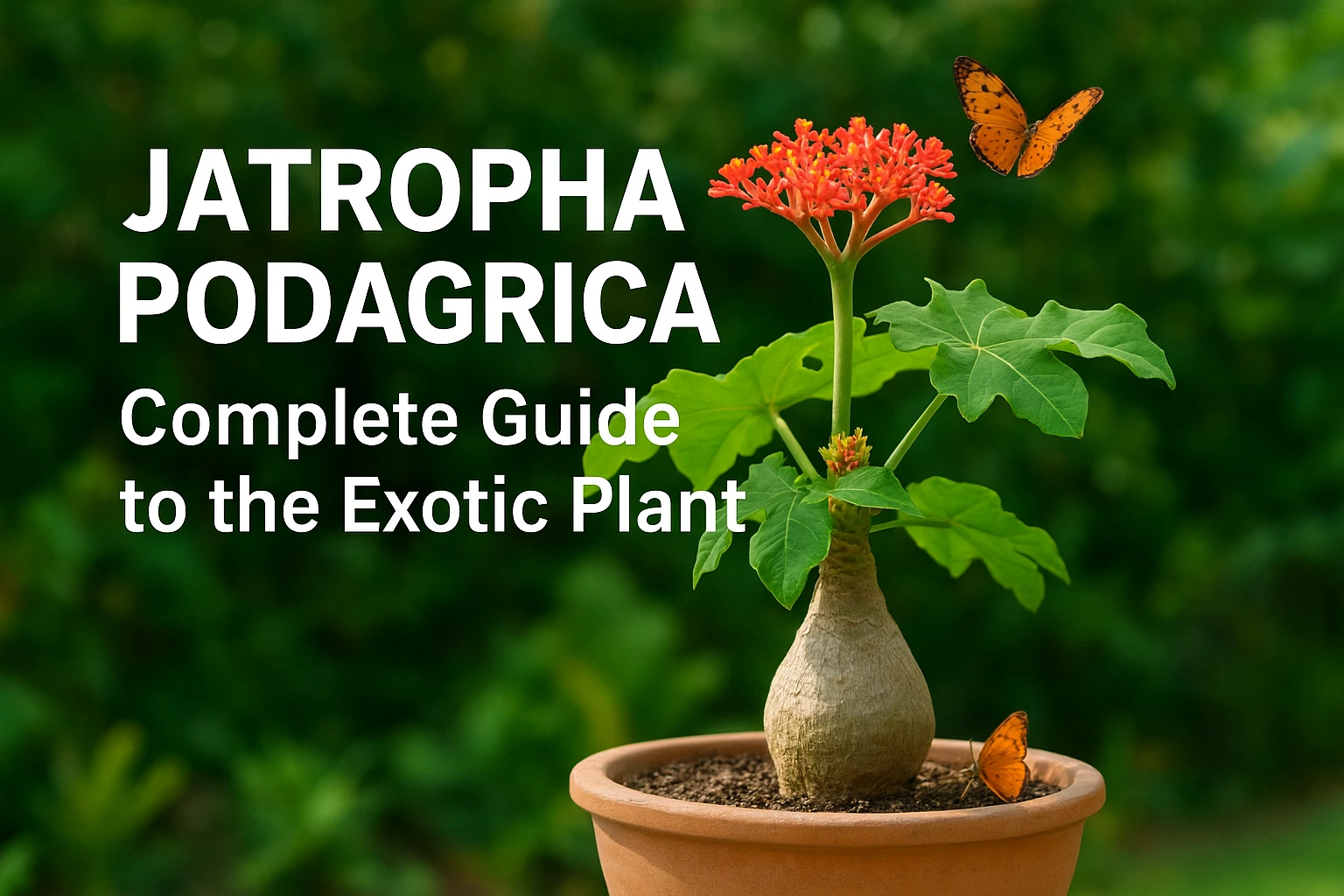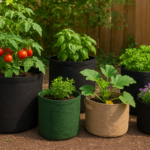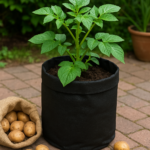Jatropha podagrica, also called the Buddha Belly Plant or Gout Plant, is a unique ornamental plant admired for its swollen trunk and bright coral-red flowers. It belongs to the Euphorbiaceae family and is popular among gardeners for its unusual appearance and resilience.
This plant adapts well to both indoor and outdoor environments, making it suitable for homes, gardens, and patios. Its drought-tolerant nature makes it low-maintenance, while the flowers attract butterflies, adding charm to any space. Beyond aesthetics, Jatropha podagrica has traditional medicinal uses, though it is toxic if consumed, requiring careful handling.
Botanical Classification and Scientific Background

Jatropha podagrica is a member of the Euphorbiaceae family, a diverse group of plants that includes poinsettias and cassava. Its scientific classification is:
Kingdom Plantae
Order Malpighiales
Family Euphorbiaceae,
Genus Jatropha
Species podagrica
The name “podagrica” comes from the Latin word for gout, referring to its swollen stem that resembles a swollen foot. Commonly nicknamed the Buddha Belly Plant, this feature sets it apart from related species like Jatropha curcas. Scientists are also interested in Jatropha podagrica because it contains phytochemicals like alkaloids and flavonoids, which hold medicinal potential but also contribute to its toxicity.
Origin and Natural Habitat
Jatropha podagrica is native to Central America, particularly regions of Guatemala, Honduras, and Nicaragua. It thrives naturally in tropical and subtropical climates, where warm temperatures and well-drained soils allow it to flourish. In its native habitat, it often grows in rocky or sandy areas, taking advantage of its swollen stem to store water during dry spells. This drought tolerance is one of the main reasons it has spread worldwide as a hardy ornamental plant. Today, you’ll find Jatropha podagrica cultivated not just in Central America but also in Asia, Africa, and other tropical regions for decoration and traditional medicine.
Physical Characteristics of Jatropha podagrica
The striking look of Jatropha podagrica makes it instantly recognizable. Its swollen, bottle-shaped stem is the most noticeable feature, which has earned it nicknames like the Gout Plant and Buddha Belly Plant. The leaves are large, lobed, and bright green, creating a beautiful contrast with the clusters of coral-red flowers that bloom almost year-round in warm regions. The flowers are small but vibrant, and they attract butterflies and hummingbirds. On average, the plant grows 2–3 feet tall, making it a compact yet eye-catching addition to gardens or pots. Its unique form combines beauty with resilience.
Jatropha podagrica as an Ornamental Plant
Gardeners and plant enthusiasts prize Jatropha podagrica as an ornamental gem. Its swollen stem makes it a standout in succulent collections, while the vivid red flowers add bursts of color to homes and gardens. Because of its manageable size, it fits well in containers, balconies, and patios. Landscapers also use it to create exotic focal points in tropical-themed gardens. Another bonus is that the plant attracts pollinators like butterflies, enhancing garden biodiversity. Whether indoors or outdoors, Jatropha podagrica adds an exotic, sculptural charm, making it a favorite choice for plant lovers seeking both uniqueness and easy care.
How to Grow Jatropha podagrica
Growing Jatropha podagrica is fairly straightforward, making it a good choice for beginner gardeners. The plant can be propagated through seeds or stem cuttings. Seeds are usually planted in well-draining soil, where they germinate in warm conditions. Stem cuttings, on the other hand, root quickly when placed in sandy soil. Since the plant stores water in its caudex (swollen stem), it doesn’t need frequent watering, which makes it quite low-maintenance. However, it does require plenty of sunlight to thrive and flower. With basic care, this exotic plant can provide a long-lasting display of unusual foliage and bright flowers.
Soil and Water Requirements
Jatropha podagrica thrives best in well-draining soil, similar to what is used for succulents or cacti. A mix of sandy soil and organic matter works perfectly to prevent root rot. The swollen stem allows the plant to store water, so it is highly drought-tolerant. Overwatering should be avoided since it can lead to fungal problems. Ideally, the soil should be allowed to dry out slightly between watering sessions. During the active growing season (spring and summer), regular but moderate watering helps maintain healthy growth, while in winter, the plant requires much less water to prevent stress or decay.
Light and Temperature Needs
Jatropha podagrica is a sun-loving plant, which means it grows best with at least 6 hours of direct sunlight daily. When grown indoors, placing it near a sunny south-facing window is ideal. Outdoors, it thrives in warm, tropical to subtropical climates where temperatures remain between 18°C and 30°C (65°F to 85°F). The plant is not frost-tolerant, so it must be protected or moved indoors during colder months. Too much shade will result in weak growth and fewer flowers. With the right light and temperature, Jatropha podagrica produces its signature vibrant red blooms almost all year round.
Fertilization and Nutrition for Healthy Growth

Like most ornamental plants, Jatropha podagrica benefits from a steady supply of nutrients. A balanced, slow-release fertilizer works best during its active growing season, usually spring through summer. Fertilizers with higher phosphorus levels encourage more vibrant flowering, while nitrogen supports healthy leaf growth. Feeding once every four to six weeks is enough to keep the plant thriving. Over-fertilizing should be avoided as it can damage the roots or cause excessive leafy growth at the expense of flowers. Adding organic compost to the soil can also improve its structure and fertility, helping Jatropha podagrica remain strong and beautiful.
Common Pests and Diseases
Although generally hardy, Jatropha podagrica can face issues with aphids, spider mites, and whiteflies, which suck sap from the leaves and weaken the plant. Regular inspection and early treatment with insecticidal soap or neem oil can prevent infestations. Fungal diseases, such as root rot, usually occur due to overwatering or poor soil drainage. Yellowing leaves are often a sign of either too much water or a nutrient imbalance. Ensuring proper airflow around the plant also reduces the risk of fungal problems. By practicing good plant hygiene and balanced care, most pest and disease issues can be easily avoided.
Medicinal Uses of Jatropha podagrica
In traditional medicine, Jatropha podagrica has been used for its anti-inflammatory and healing properties. Various cultures have applied parts of the plant to treat ailments such as skin infections, fevers, and digestive problems. Research shows that it contains alkaloids, flavonoids, and diterpenes, compounds linked to medicinal benefits. However, while it has been valued in folk remedies, it is important to note that the plant is toxic if consumed improperly. Its sap can irritate the skin, and ingestion may cause serious health issues. Therefore, Jatropha podagrica’s medicinal potential should always be approached with caution and professional guidance.
Toxicity and Safety Concerns
While Jatropha podagrica is admired for its beauty, it is also considered toxic. All parts of the plant, especially the seeds, contain compounds that can be harmful if ingested. The sap may cause skin irritation or allergic reactions, and accidental consumption can lead to nausea, vomiting, or more serious symptoms. Because of this, it’s crucial to keep the plant out of reach of children and pets. Gardeners should wear gloves when pruning or handling the plant to avoid contact with the sap. Appreciating its ornamental charm is safe, but awareness of its toxicity is equally important.
Jatropha podagrica in Landscaping and Indoor Decor
Jatropha podagrica is not only fascinating biologically but also highly versatile as a decorative plant. Its swollen trunk makes it a natural focal point, while the red flowers bring a burst of color to gardens and patios. In landscaping, it pairs beautifully with succulents and other tropical plants, creating an exotic garden theme. Indoors, it thrives in bright, sunny spots like balconies or windowsills, adding a sculptural touch to modern interiors. Its compact size makes it perfect for pots, and when grouped with other caudex plants, it creates an impressive collection. Jatropha podagrica truly blends art with nature.
Eco-Friendly and Sustainable Uses
Beyond its ornamental value, Jatropha podagrica has a role in sustainability and ecology. Its flowers attract pollinators such as butterflies and hummingbirds, supporting local biodiversity. In some regions, Jatropha species are studied for their potential in biofuel production, thanks to their oil-rich seeds. While Jatropha podagrica itself is less used for fuel compared to Jatropha curcas, it still contributes to research and awareness about sustainable energy crops. Its drought tolerance also makes it suitable for xeriscaping, a landscaping method that reduces water use. Thus, growing Jatropha podagrica can be both a decorative and environmentally conscious choice.
Care and Maintenance Tips for Long-Term Growth
To keep Jatropha podagrica thriving for years, consistent but simple care is essential. Below are key tips:
- Watering: Allow the soil to dry slightly before watering again. Overwatering leads to root rot.
- Pruning: Trim off old or damaged leaves to encourage fresh growth and maintain shape.
- Repotting: Every 2–3 years, repot the plant into fresh soil to avoid nutrient depletion.
- Pest Check: Inspect regularly for aphids and spider mites, treating early with neem oil.
- Seasonal Care: In winter, reduce watering as the plant rests, while in summer it enjoys more frequent feeding.
FAQs
1. Is Jatropha podagrica easy to grow indoors?
Yes, it grows well in pots indoors, provided it gets bright sunlight and well-draining soil.
2. Can Jatropha podagrica survive drought?
Absolutely. Its swollen stem stores water, making it naturally drought-tolerant.
3. How often does Jatropha podagrica flower?
In warm climates, it blooms nearly year-round, especially during spring and summer.
4. Is it safe to touch Jatropha podagrica sap?
No, the sap can irritate skin and should be avoided. Gloves are recommended when handling.
5. What makes Jatropha podagrica different from other Jatropha species?
Its distinctive swollen stem and compact size set it apart from species like Jatropha curcas.
Conclusion
Jatropha podagrica is a truly remarkable plant that combines beauty, resilience, and cultural significance. With its swollen trunk, vivid flowers, and drought-tolerant nature, it stands out as both an ornamental showpiece and a hardy survivor. Its ability to attract pollinators enhances biodiversity, while its low-maintenance care makes it suitable for both beginners and experienced gardeners. Though toxic if mishandled, with proper precautions it remains a safe and rewarding choice. Whether grown indoors in pots or outdoors in tropical gardens, Jatropha podagrica is a plant that effortlessly blends elegance with uniqueness, making it a prized addition to any collection.







